Introduction
Background of the study
Forkel and Klenner (2004) indicate that High Speed Packet Access (HSPA) is a set of mobile phone protocols that is a function of three components namely High Speed Downlink Packet Access (HSDPA), High Speed Uplink Packet Access (HSUPA) and Evolved High Speed Packet access (EHSPA). The architecture of HSDPA is illustrated by figure 1.
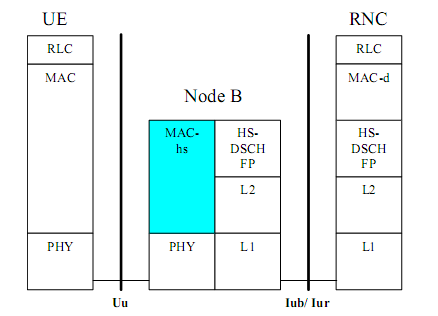
Geirhofer, Mehifuhrer, and Rupp (2005) suggests that HSPA results into better Quality of Service (QoS) through improved end-user Quality of Experience (QoE) by increasing peak data rates that attain 14 Mbits/s in the downlink and up to 5.8 Mbits/s in the uplink. HSPA leads into decrease of latency and contributes to better system capacity in both downlink and uplink when compared to WCDMA protocol. HSPA improved data rates by utilizing a shared channel transmission that maximizes efficiency of the codes and power resources in a WCDMA protocol. HSPA higher data rate is brought about by reduction of Transmission Time Interval (TTI) as this has potential to lower round-trip time and improves tracking of fast channel variations (Ameigeiras, 2003). HSPA data rate improvement is achieved via link adaptation as this has capacity to maximize channel utilization and makes it possible for the base stations to operate close to maximum cell power. HSPA data rate improvement is attained via fast scheduling as this prioritizes end users that have best channel gains. HSPA data rate transfer is a function of fast retransmission that is meant to account for system capacity improvement. HSPA data rates are a subset of a 16 Quadrature Amplitude Modulation (QAM) that makes it possible to attain high bit rates (Andrews, Kumanan, Ramanan et al, 2004).
HSPA rollout is achieved through a software upgrade from either 2G to 3G networks and even to higher networks like 3.5G or 4G. The software upgrade makes HSPA more superior compared to WiMax which is dependent on a network infrastructure (Arauz, Krishnamurphy and Labrador, 2004).
High Speed Downlink Packet Access (HSDPA) is the most recent adopted technology for data transfer for the mobile phone telephony protocol. The HSDPA is termed as the 3.5G technology (Figure 2)
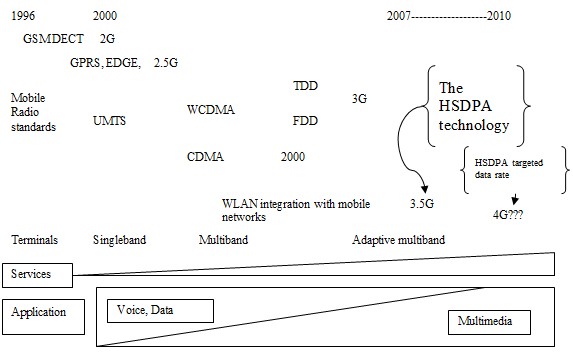
For a broadband connection in a personal computer (PC) or a Laptop, normally an Asymmetric Digital Subscriber Line (ADSL) is used since it provides high bandwidth for data downloads. HSDPA (Figure 1) has equivalent data downloads characteristics like the ADSL. Introduction of HSDPA was secondary to Wideband Code Division Multiple Access (WCDMA) technology. HSDPA was favoured to WCDMA because it attains higher data transfer rates compared to WCDMA to the order of five times for downloads rates and two times for uploads rates (Bao, 1996).
HSDPA makes it possible to achieve a data rate range of 8-10 Mbits/s which makes it possible for a mobile phone to carry out different applications fast. HSDPA has made it possible towards improvement of media streaming namely video and audio on a mobile phone (Jiang, Ge and Li, 2005).
HSDPA utilizes High Speed Downlink Shared Channel (HS-DSCH) as in a WCDMA protocol. The HSDSCH is utilized for faster downlink speeds and employs a mutual connection amongst a variety of end-users who are connected to it. The transmitted data could be voice, video, picture or graphics commonly termed as multimedia data (Wise Geek, 2009).
Overview of HSDPA
HSDPA has been mentioned in 3GPP release 5 and 3GPP release 6 where it is indicated that HSDPA is an extension of WCDMA subject to additional transport and control channels like HS-DSCH that has potential to provide support for interactive and streaming capabilities. The 3GPP release 6 reports enhanced uplink for the HSDPA. According to 3GPP release 6, HSDPA supports enhanced dedicated channel (E-DCH). Enhanced uplink for mobile telephony should support mobile broadband with potential for a possible 5.8Mbits/s that is not affected by delay and supports up to 150-200% greater system capacity (3GPP. TR 25.848V4.0.0, 2001).
HSDPA creates enhancement for WCDMA by adopting techniques that provide for modulation and coding. HSDPA achieves this potential by creating a channel within a WCDMA that is termed as HS-DSCH. HS-DSCH makes it possible to attain faster download. This means that the HS-DSCH is applicable for downloads meaning the data is cannot be sent from the mobile phone. The HS-DSCH is shared among different end-users and this makes it possible for the radio signals to be used effectively for downloads (3GPP. TR 25.950V4.0.0, 2001b).
Widespread application of HSPDA is likely to fail to achieve the targeted timeframe or fail to be realized fully in some areas. This is because HSDPA is depended on initial application and successful implementation of 3G network framework. 3G network was not implemented in many countries by the end of 2005 although mobile providers in different countries are trying to implement 3G networks because it forms foundation for upgrading to 3.5G network (members of 3GPP, 2004a). The HSDPA application is therefore dependent on initial existence of 3G network. There is possibility that the services may attain lower data rates to the order of 1.8Mbits/s which means upgrades can occur with data rates to the order of 3.6Mbits/s subject to availability of supporting devices that can support high data rates (Baumgartner, 2003).
It is therefore envisioned that HSDPA may fail to achieve widespread application due to limitations of dependence on 3G network for upgrade to 3.5G network and competitive advantage of other higher data rate transmission that can be achieved via use of techniques like CDMA2000 1xEV-DO and WiMax. This means without success of WCDMA, the potential to adopt HSDPA and attain 3.5G network capabilities will remain a target that will not be realized (Members of 3GPP, 2003).
Characteristics of High Speed Packet Access (HSPA)
HSPA technology is upgrade of 3G network into a 3.5G network. HSPA is used in the mobile technology for primarily for internet access. HSPA is divided into two main categories namely HSDPA and HSUPA (members of 3GPP, 2004b). The HSDPA has potential for fast download of internet file downloads and supports email attachments, PowerPoint, video and audio applications. With this it will be very easy for the user too access the files very easily. It has been here for more than 2 years. The HSDPA has the capability for providing the speed up to 14.4Mb/sec. The major advantage of this is even a small video clip can be downloaded very fast and not only this it is very easy for one to watch streaming video live from the internet (Bao, 1996).
HSUPA supports high speed uplink packet access. HSUPA makes it possible to upload files from the mobile telephone though this occurs at lower speeds.
Universal Mobile Telecommunication Systems (UMTS)
Universal Mobile Telecommunication System (UMTS) is third generation mobile system. UMTS supports a greater percentage of operators and manufactures. UMTS creates user friendly access to the mobile features (ETSI, 1998). The UMTS architecture consists of Core Network, UMTS terrestrial Radio Access Network (UTRAN) and user equipment. The main function is to provide facilities for the traffic via switching, routing and transit in the traffic (Bauggren and Jantti, 2004).
Voice Telephony and Multimedia Application
The voice telephony is the single integrated infrastructure which is able to administer and distribute to the supported signal like audio signal, data signal, voice signal and video signal. There has been increase in subscriber base for the mobile internet access. Due to increased demand of internet, the need for broadband connectivity has also increased proportionally which has put pressure on need to improve web based application or multimedia application (Bakre and Banrinath, 1995).
Multimedia application is made up of four different types of components namely text, audio, graphics and video.
The term text application is derived from the mode of input which is basically via the keyboard. An example of text message includes an e-mail or SMS. Text application is commonly adopted for storing the databases (Baumgartner, 2003). The term audio is used to indicate either speech or voice. The primary application that utilizes voice multimedia mode is the telephony. Instances of voice multimedia application include voice mail, audio teleconferencing and telemarketing. Music downloads and uploads are inclusive of the voice application multimedia (Mailaender, 2001).
The OSI model, the Cross layer optimization, contains a RLC layer that is structured such that it provides transparent, unacknowledged or acknowledged mode of data transfer to upper layers. The primary role of the RLC layer is to cipher data and facilitate Automatic Repeat reQuest (ARQ). The MAC layer on the other hand is primarily use to map logical channels of the RLC to the transport channels at the Physical layer (PHY) (Wu, and Negi, 2003).
When the MAC layer receives information from RRC on QoS that ought to be supported, the MAC layer performs resource allocation and prioritizes mechanisms of handling different flow of data.
TCP (figure 3) is the widespread used protocol for the IP that is used in facilitating retransmission. The structural design of the TCP is such that it is able to perform well in wireline networks where channel error rates are low and where congestion that may results is subject to loss of packed data. In a wireless system, TCP is subject to high bit error rate hence leading into a degraded performance (Schniter and margetts, 2002).
However, when TCP. In terms of packed data loss, any loss in the wireless link is interpreted as congestion cause subject to TCP. The reaction these results into reduction of the window size which results into congestion control mechanism and retransmission time is reset. In this case, the congestion control mechanism that is developed for wireline networks causes unnecessary reduction in TCP throughput (Wu and Negi, 2003).
A variety of schemes have been proposed to help in improving effects of non-congested related losses that are encountered in wireless links. What happens is that retransmission of the distorted data packets in say one scheme recovers erroneous frames before TCP timer expires and a time out occurs and this has an effect of leaving the TCP throughput unaffected.
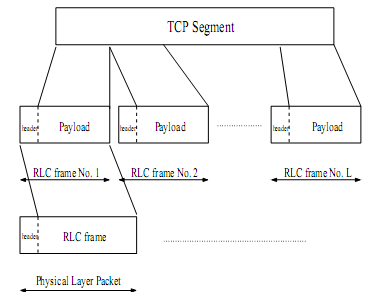
The primary goal of radio link control is to shield the impacts of loss over wireless links resulting from the TCP layer (Comer, 1991). The RLC divides the upper layer packet which is either an IP packet or a TCP segment into several RLC frames before transmitting over a wireless channel thus taking features of an OFDM system but without othorgonality characteristics via subcarriers. The primary goal of fragmentation is to make it possible to increase granularity of the transmission. In this case, when an error results, an RLC frame which is much smaller is affected instead of the whole TCP segment. If there occur a scenario where a RLC frame loss occurs during transmission, the RLC utilizes ARQ error recovery mechanism to retrieve the lost RLC frame. This process for recovering erroneous frames is started by the receiver by requesting retransmission of the damaged frame. The recovery process of the erroneous frames ought to be carried out before the TCP timer expires if the TCP throughput is to remain unaffected (Choi and Limb, 1999).
Data retransmissions at MAC Layer
The radio control protocol is enough to protect the PHY layer impairment from the TCP but sometimes it fails when the application encounters strict delay requirements. Under normal conditions, the delay encountered at the RLC is sufficient to sustain a real time application. Equivalent problems are observed when dealing with interactive real time traffic. There is possibility that the TCP timer is likely to time out before the RLC fully recovers any missing frames. In such cases, the delay associated with retransmission at RLC a lower layer for fast MAC retransmission is used.
The faster retransmissions make it possible to provision better round trip time for real time applications. The number of transmissions that a MAC layer is able to allow is small which means it cannot eliminate possibilities of having missing or damaged frames. In the event the ARQ fails to deliver a frame correctly, even after retransmitting the maximum allowed times then the responsibility is shifted to RLC in order to retrieve the frame. This means it’s possible to achieve two layers for retransmission reliability (figure 4).

Objectives of the study
- To use simulation model to analyze delay characteristics, data packet throughput and RLC recovery for the values ranging from M=1, to M=2 and project for higher values of M (maximum number of allowed retransmission) by using comparison of three algorithms namely APO, OOS and MLWDF.
- To use simulation model to determine misinterpretations that have potential to affect the delay characteristics, data packet throughput and RLC recovery at different values of M (maximum number of possible retransmission) by using comparison of channel usage efficiencies subject to three algorithms viz APO. OOS and MLWDF.
- To compare channel usage efficiencies of three algorithms thus APO, OOS and MLWDF subject to slot assignment for scheduling cycles.
- To carry out comparative studies on quality of service performance analysis based on three algorithms thus APO, OOS and MLWDF by using service curve.
- To use channel usage efficiencies to compare three algorithms namely APO, OOS and MLWDF to determine delay and buffer size for the nRT and RT users.
Motivation for the study
The number of mobile technology users has been increasing with increasing subscriber base which results into congestion in the networks. The congestion of a network subject to increased density of users reduces speeds of data transmission and QoS and QoE is greatly affected.
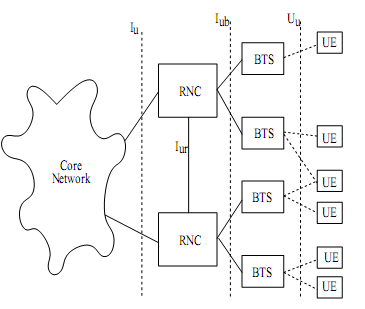
Analysis for the WCDMA architectural support
The architecture proposed for Universal Terrestrial Radio Access network (UTRAN) in figure 5 is such that Radio Network Controllers (RNC) is connected to the core network (3GPP.TR 25.848V4.0.0, 2001a). The RNCs are connected amongst themselves through Iur interface (figure 6). It was found that every RNC supports multiple base stations or base transmitter systems (BTS). This provides for User Equipment (UE) ability to communicate directly with the BTS via the Uu interface. The interface protocol stack for the WCDMA consists of three layers that are namely first layer which is a PHY layer like in an OSI model for the Cross Layer Optimization, second layer that has four inter-linked layers termed as the Medium Access Control (MAC) which consists of Radio Link Control (RLC), that also links broadcast or multicast control and the packet data convergence protocol (Al-manthari, Nasser and Hassanein, 2006).
The third layer contains the Radio Resource Control (RRC) and this is responsible for Radio Resource allocation to the UEs (figure 6). The RRC performs control plane and user plane signalling between the UTRAN and the UEs and brings about a negotiated QoS to the UEs. In order to achieve the required QoS, RRC sends control signals to all sublayers in the second layer through Service Access Points (SAP). It can also be said that any application can provide data to the RLC via the appropriate SAP.
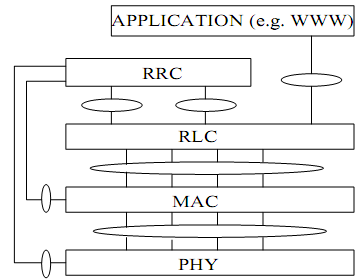
The performance of HSDPA is greatly affected by interruption of transmission of the packet data. Therefore studies on reduction strategies for the interruption of packet data transmission would help to resolve the problem and create a potential for enhanced maximization of the number of users via the downlink packet data transmission (3GPP.TR 25.950V4.0.0, 2001b). The problem could be addressed by utilizing a system that has capabilities of maintaining sufficient compatibility. This should be done by utilizing mechanisms that have ability to achieve integratable compatibility such that the HSDPA system can support methods laid down by 3GPP release 99. There is need to adopt networks that can support UE in order to enhance interoperability by creating compliance with a variety of methods stated by the 3GPP release 99. With HSDPA, the 3GPP release 5 was introduced based on UTRAN functional hierarchy that has not been exhaustively researched (3GPP.TR 25.848V4.0.0, 2001a). The new technology has failed to have any impact on RLC since all modifications have been based on MAC layer of the OSI model of Cross layer optimization (members of 3GPP, 2004b).
Outline of the project
The rest of the dissertation is organized as follows. The chapter two addresses the literature review on HSPA and achievements of past research work on HSPA. The literature reviews the differences between the current study and previous studies on HSPA and concludes by providing knowledge that the current study adds to the literature of the HSPA. Chapter three looks into the architecture and stack protocol of the HSPA system subject to HSDPA, HSUPA Evolved HSPA. It also addresses the mechanisms through which data packets are transmitted at the RLC and the MAC layers. Chapter three provides analysis of the simulation model as a component of mechanism through which packet data delay, throughput and RLC recovery is carried out. Chapter four presents the simulation results that are obtained after carrying out packet transfer subject to delay, throughput and RLC recovery across the MAC and RLC layers following comparison studies on three algorithms namely APO, OOS and MLWDF. It also provides analysis of misinterpretations and possibilities of false ACKs and NACK effects subject to channel usage efficiencies from three compared algorithms thus APO, OOs and MLWDF. Chapter five provides conclusion based on the simulation model. It provides policy framework that ought to be implemented and proposes future research work based on the results of the simulation.
Previous work on HSPA
A lot of studies on performance characteristics of HSPA have been carried out. Some authors have performed studies on EUTANE as a subset of HSPA. The methodology of the research studies have been based on adding several HSDPA in a sequence to make an end to end extension that is termed as EUTANE. This application has then been converted into a NS-2 system. Other studies have been based on simulating the HS-DSCH for the analysis of the HSDPA performance characteristics subject to determining the QoS and QoE of the channel. Other researchers have implemented a variety of techniques that have been targeted towards determining the resource allocation as a subset of power consumption on HS-DSCH channel (figure 10). On the other hand, other studies on HSPA have been focused on developing algorithms that can be utilized to improve the QoS of the HSPA systems.
Research work on QoS support scheduling algorithms in wireline networks have been carried out with results indicating that the QoS support scheduling algorithms cannot support wireless network systems especially HSDPA and HSUPA. This is because the QoS support scheduling algorithms lack capabilities for radio link conditions adaptation.
Methodology for the study
The study on the HSPA focused on the enhancement of various HSDPA algorithms in order to increase the data transmission speed. It is possible to increase the speed of HSDPA data transmission by varying different form of HSDPA algorithm and the user’s applications with aim of increasing overall systems capacity by using a NS 2 (Network Simulator 2) base simulator and EURANE (Enhance UMTS Radio Access Network Extension).
The objective of the study was achieved by carrying out simulation using network simulator 2 to analyze delay characteristics, data packet throughput and the RLC delay at varying values maximum number of allowed transmission M for the MAC sublayer and the RLC frame by comparing channel usage efficiencies of three algorithms namely OOS, APO and MLWDF. The network simulator 2 simulation model was also used to determine the misinterpretations that had potential to affect delay characteristics subject to rayleigh fading environment, data packet throughput and the RLC recovery rates subject to MAC sublayer and RLC frame maximum allowed retransmission and project for higher values of the M (the maximum allowed number of transmission) all whose results were compared for channel usage efficiencies using three algorithms namely APO, OOS and MLWDF. The NS 2 simulation model was used to determine possibilities of misinterpretation at the MAC layer of ACK or NACK and how the misinterpretation affects the delay, throughput and RLC recovery subject to channel usage efficiencies among three compared algorithms OOS, APO and MLWDF.
Literature review
Introduction
This section reports on improvement of High speed Packet access as a function of high speed Downlink packet access and high speed uplink packet access. It looks into past research work on High speed packet access and methodology that were used. It looks into achievements that were made by previous past research work and studies on high speed packet access. It looks into the methodology of the study and differences that exists between the current study and past research work. It provides an analytical framework on the body of knowledge that this study adds into the literature of high speed packet access.
Although CDMA-EVDO took an early lead in terms of performance, HSDPA has enjoyed an increased subscription and many mobile service providers are adopting it. In some countries like Australia and Austria, the CDMA-EVDO has already been phased out in favour of HSDPA. Mobile service providers in countries like Canada, in 2007 and to 2008, developed strategies that were meant to expand their EVDO and CDMA networks to include HSDPA (figure 7).
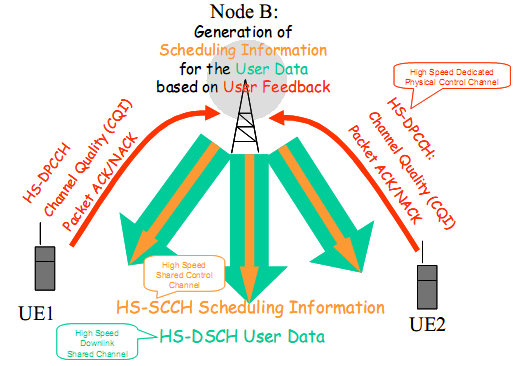
The reasons behind HSDPA enjoying the favors amongst many mobile service providers is because TCP has remained a major suite for the IP and has ability to provide end-to-end transmission reliability in the wireline domain. With rise in proliferation of World wide web (WWW) and integration of www into the people’s lifestyles, mobile service providers have been forced to provide services that support wireless domain that include speech, audio, video streaming, file and web components downloads (members of 3GPP, 2004a).
The principle of the HSDPA is a function of different technology combination. The QoS achieves improvement if a new upgrade on the transmission channel is added to the user data which could be Hish Speed (PHY) Downlink Shared Channel (HS-(P) DSCH. The improvement is brought about by ability of the multiple users to share the air interface resources that are available on the channel. The channel has an intelligent algorithm in the node B which decides which subscriber receives packet data and at what time this should take place. This is reported to the multiple users through parallel signaling channel and the high Speed Shared Control Channel (HS-SCCH).
Contrary, the UMTS new data packet is transmitted at least every 10 ms subject to HSDPA data packet transmission taking place after every 2 ms. Other possible innovations include using adaptive modulation and coding mechanism. In this case, every end user regularly sends messages regarding the channel quality to the node B. depending on the quality of the mobile device channel conditions. It has been reported that the node B has potential of selecting the modulation methods like the Quadrature Phase Shift Keying (QPSK). Although QPSK has been used in UMTS release 99, the 16 QAM has capabilities of providing highest possible data rates for the HSDPA system (members of 3GPP, 2004b).
If the target is achieving robust data transmission, the HSDPA achieves this goal by utilizing HARQ (Hybrid Automatic Repeat Request) protocol. If there is an event where the UE receives a data packet that has errors, it immediately requests the retransmission of the data packet again. At the time when the retransmission process is being repeated, the node B selects a different coding version that is able to provide the subscriber with a better reception for the packet data through implementation of a incremental redundancy. This type of coding version is termed as the redundancy and constellation version or RV version (BAuch and franz, 1998).
If the packet is transmitted to the UE, the node B is forced tom wait until acknowledgement (ACK) or negative acknowledgement (NACK) is received concerning the specified packet data. This follows the stop and wait transmission mechanism. When this is taking place, the node B is still able to transmit other data packets to the UE by using other HARQ processes. This is because the UE has potential to effectively support up to 23 or 8 parallel HARQ processes that are equivalent to 8 independent HARQ stop and wait transmission mechanisms (members of 3GPP, 2003).
Even though developments have been witnessed in the wireless communications, the wireless communication advancement have relied on IP based networks in order to leverage dominant IP based infrastructure. This means in order to support www traffic to the mobile handsets, it calls for a suitable protocol that should address the growing demands of data services over wireless channels. One possibility has been WCDMA or wideband CDMA that has been specified by the 3GPP as a possible emerging global 3G radio access technology. According to WCDMA specifications, data rate support occurs up to a possible 2 Mbits/s for indoor and small cell outdoor environments and possibilities of up to 384 Kbits/s in wide area coverage. This is in line with IMT-2000 requirements. This requirement supports high rate packet data and high rate circuit switched data (Kolding, Pedersen wigard et al, 2003).
The frame structure for the WCDMA (figure 8) downlink is illustrated by the figure below. For every 10 ms frame, there exists 15 slots each with a potential of 2/3 ms that contains both data and control information. The data is carried over the dedicated PHY layer channel (DPLCH) while control information is carried over Dedicated PHY Control Channel (DPCCH). The DPCCH (figure 9) consists of the Transport Power Control (TPC), the Transport Format Configuration Indicator (TFCI) and the Pilot Channel (PC).

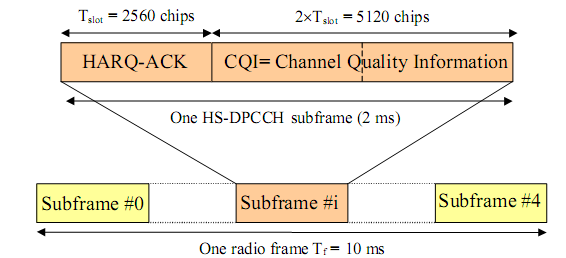

The challenges that face implementation of 3.5G network from 3G network is capability to handle a variety of multimedia services that have varied QoS requirements. In seeking a solution to this problem, the foundation to improve WCDMA air interface beyond 3G network subject to demand for packet data services, was realized. The proposed solution paved way for the HSDPA in order to allow instant bit rates of up to 10 Mbits/s for the Best Effort (BE) packet data services but subject to limits defined by delays and capacity. This was achieved by utilizing fast scheduler located at the base station such that the HSDPA made allocations to users that had best channel gain and able to transmit at highest possible data rate. This meant that users had to utilize HSDPA if and only if their downlink was excellent (Freudenthaler, kaltenberger and Paul, 2005).
The notable principles of HSDPA include fast link adaptation, fast scheduling and fast retransmissions of erroneously received data packets (Kaltenberger, Freudenthaler, Paul et al, 2005). This implies that if a receiver was to detect a packet in error, a request for retransmission would be called but there was no possibility where the receiver was able to discard received soft information associated with the incorrectly received data packets. HSDPA buffers the data and combines the buffered data with the received soft information of the retransmitted bad data packet. Similarly, this type of packet combination mechanisms had made it possible for the reliability of the CDMA systems. The error recovery mechanism is initiated by the RLC that stimulates retransmission to salvage the damaged data packets. It has been established delay associated with retransmission at RLC cannot sustain real time application. However, studies have reported that if a retransmission at the MAC layer is supported then it is found that the delay is infinitesimally small (Harteneck, Bollorian, Georgolous, et al 2004).
The scheduling algorithm that is commonly used is the Maximum SINR or the maximum SINR algorithm. Maximum SINR is characterized by ability to attain the highest instantaneous satisfactory data rate transmission. The Max SINR algorithm is found in every TTI. The maximum SINR attains highest cell throughput that is applicable in other models. The other commonly used algorithm is the Proportional Fair (PF)
In scenarios where weighted delay is an element that needs to be addressed, a PF algorithm is adopted. PF metric will be dominating the scheduling judgment while the HOL delay is short (Caceres and Iftode, 1995).
PF metric is dominant in scheduling judgement as opposed to HOL delay that is short which creates easy application for the PF algorithm. This aspect is a major concern in process of designing an algorithm that is able to attain higher data transmission rates.
It is therefore important to note that one concern for simulation is to achieve potential for high data rates transmission while still ensuring the simulation achieves potential for linking a variety of multi-users in the order of 2n where n is an index whose values range from 1 to infinity but n is not equal to zero. Thus the numbers of users form a GP series thus 21=2, 22=4, 23=8, 24=16, 25=32 etc.
These multi-users should be downloading data via HSDPA link HS-DSCH from a node B by using either TCP or UDP protocols or traffic models. TCP is a transmission control protocol as well as a connection based protocol (Chan and Han, 2002). A HSDPA mobile network can start after sending data after the connection between two end-points has been established. In the case of User Data Gram protocol (UDP), there is no requirement for connection between two end points to be initialized before commencing HSDPA data transfer.
The Rayleigh fading environment (RFE) is a model that achieves a high propagation limit when on a high frequency radio signal or subject to other wireless unguided devices. The RFE models perform on the basis of the principle that degree of a signal that penetrates through a transmission medium namely a guided medium or unguided medium is subject to variations and the fading is affected by the length of the transmission medium (Chaporkar and Sarkar, 2002).
In such a case, the physical channel is termed as the guided medium and the wireless transmission channel is termed as the unguided medium. The physical medium includes Co-Axial Cables (CAC), Twisted Pair Cables (TPC) and a variety of wireless media. The unguided medium on the other hand includes satellite transmission, microwave infrared and other waves or radiations that have lower wavelengths or higher frequencies. The HSDPA is concerned with unguided medium as opposed to the guided or physical media (Chockalingam and Bao, 1999).
A variety of operators are using HSDPA technology for instance in the UK, operators like 3 UK, O2, Orange UK, T-Mobile UK and Vodafone have already implemented HSDPA subject to successful implementation of WCDMA that forms basis for the upgrade from 3G network to 3.5G network. On the other hand, in the USA, mobile service providers like AT & T and T-Mobile USA have adopted the HSDPA technology. The utilization of HSDPA technology across nations that have implemented 3G networks has formed foundation for improving the 3.5G to possibilities of 4G technology networks. More research work on HSDPA technology has created high expectation for the expansion of 3.5G networks to higher order but faces stiff challenge from other high data rates mechanisms like WiMax that are independent of upgrade of 3G networks.
Following implementation of HSDPA by many mobile service providers, different customers are using HSDPA. Research work is ongoing on different mechanisms for improving QoS and QoE. Research on HSDPA is not exhaustive since HSDPA was introduced recently and its coverage to all nations is being limited by dependence on 3G network or WCDMA. This means the potential for developing HSDPA as primary download mechanisms for mobile telephony is high and market value for HSDPA in countries that have implemented HSDPA is high (Valenti and Sun, 2001).
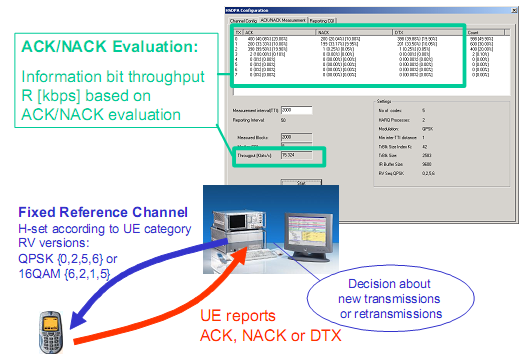
Mobile service providers face the challenge of improving QoS and QoE subject to increased data rates and connection reliability (figure 11).
The primary tasks envisioned for the HSDPA is to improve end users QoE subject to cost efficiency and sustainability by upgrading WCDMA or UMTS networks as well as meeting requirements for Local Area Network (LAN). The wireless LAN service can also be attained by utilizing WI-FI technology. The principal advantage of WI-FI technology is creating value to the benefit of mobility and ubiquitous coverage.
HSDPA makes it possible for fast packet scheduling. The HS-DSCH downlink channel is shared among different users by making use of a channel dependent scheduling. Channel dependent scheduling achieves the advantage of making the best use of available radio conditions. Every receiver device has capability for transmitting downlink signal quality to the tune of 500 times a second. By utilizing information from the end receivers, the base station is able to send data on the next two MS frame and be able to determine data allocations that ought be sent to the end receivers or users. A greater percentage of the data is sent to the end-users devices that report high downlink signal quality (Wu and Negi, 2003).
Based on the magnitude of channelization code tree, hence potential for network bandwidth, resource allocation to end-users devices on HSDPA is dependent on the network. In this aspect, the resource allocation to end-user device can be said to be ‘semi-static’ if it has capabilities of being able to be modified when the network is in operations. The modification is not possible for frame-to-frame. This implies there exists a tradeoff between the allocated bandwidth for the end-user device HSDPA compared to voice and non-HSDPA end-user devices (members of 3GPP, 2003).
The allocation units for the channelization code spreading are based on a factor 24 =16, where 24 is member of the set and subject to degrees of freedom meaning 15, which is one unit less than 24 satisfies degree of freedom element and is therefore allocated for in the HSDPA. It is responsibility of the base station to decide which end-user device receives data on the preceding frame while still making decision on which end-user device does the channelization codes are utilized for the end-user device. The information is sent from the base station to end-user device through one or multiple scheduling channels which are not part of HSDPA previous allocation. The scheduling channelization is independent. If for instance there exists two MS frames, the data is sent to different end-user devices simultaneously via a variety of channelization codes. Contrastingly, in the case of CDMA2000 1xEV-DO, the data is sent to one end-user device at a time (members of 3GPP, 2004a).
HSDPA UE categories
Table 1: HSDPA User Equipment (UE) categories
HSDPA comprises various versions with different data speeds.
Source: Cessner, C. (2005) High Speed Downlink Packet Access (HSDPA): Test and Measurement Requirements, Rohde & Schwarz: 1MA82_0e
The Simulation Model
Introduction of the simulation model
This section reports on the simulation model that was used to carry out studies on the HSPA as a function of HSDPA.
Analysis of the simulation model
The primary goal of the simulation model is to provide a theoretical framework that will provide information on data packet reliability that is offered by joint RLC and the MAC layer of the HSDPA system by providing required support for the http data traffic and improving the QoS and QoE that the end user devices ought to demonstrate.
The HSDPA model is configured such that the model wireless channel exhibits ITU-A channels and achieves soft packet combinants at the end-receiver device with capabilities for decreasing Frame Error Rate (FER). This is made possible by factoring possibilities for mis-interpretations of acknowledgements via a minute fraction at the MAC layer subject to fast decoding. The simulation model is then tested by simulation experiments that are meant to investigate delay characteristics and throughput that is experienced by the MAC layer as well as the RLC layers. This is performed for a defined number of retransmissions. The simulation experiments should demonstrate if there is tremendous gain in the MAC layer subject to at least one retransmission and determine possibilities of lack of gain if more than one retransmission occurs. The simulation experiments should demonstrate if the rate of recovery of the missing frames at the RLC layer is pronounced at higher FER values. There should be determination of whether there results of misinterpretations of acknowledgement s are high and the ranges that they occur (Turin and Vannobelen, 1998).
HSDPA has capabilities for fast ARQ mechanisms that have potential to deliver ACK or NACK synchronously subject to the ARQ phases that are received. This means that if a NACK has to be sent, the mobile device should not wait for the hole. This implies that the mobile device should have capability for sending the NACK within a fixed period of time that is offset from the receipt of the frame in error. In this respect, the base station receiver is supposed to decode the NACK and execute a retransmission in HSDPA. The Base station receiver should not route the NACK to a central entity like for instance the BSC. This will be achieved in a HSDPA scenario because the mobile receiver will receive frames from only one base station at a specific time period. It should be noted however that if there is a shift in the base station, for instance the base station is moved from point A to point B, where points A and B are at varying lengths measured in metres, a restart of fast ARQ should be carried out in order to reflect the change in the mobile station (Shao, Shen , Zhang et al, 2003).
The simulation model
In order to achieve the targeted objective, the simulation experiment should realize the average delay and throughput. The simulation model should be such that it assumes the RLC payload is of a constant size and further achieve the null hypothesis that every RLC frame has capability to map to only one PHY layer frame. In order to make this realistic, http should be taken as the application that ought to be supported in order to address the challenges that arise due to inability to achieve sustainable real time WWW traffic on the mobile device terminals (Schniter and Margetts, 2002).
Capability for combining data packets
The end receiver should not be able to combine data packets from one ARQ phase with any other. This is based on the assumption that outband signaling is sent on a forward control channel concurrently with every frame the end-receiver receives on the forward shared channel DS-DSCH or the downlink shared channel. It ought to be realized that FER that is experienced by a data packet during the first transmission is not equivalent to the FER that is experienced during the second transmission. The observed difference of 3 Db gain in bit energy to noise ratio is due to packet combining
Efficiencies of the FER
If there occurs a situation where the data packet fails to be decoded at the end user’s device, the data packet should not be discarded but instead the data packet should be stored in the buffer and be utilized to recombine the data packets with potential for a resultant gain represented by the Eb/N0 ratio. In the event that the packet data fails completely to be decoded even after packet data combination, the data packet ought to be retransmitted for the second time where M=1 if it is possible in the MAC layer else be retransmitted via the RLC. It should be noted that during second retransmission of the packet data, the gain realized in the Eb/N0 ratio increases to 6 db. This means that following any retransmission, there is a gain of 3 db. By looking at an indoor A channel that has ¾ rate QPSK modulation, it can be deduced that subject to simulations, the effective FER (table 2) successive retransmission (RET) is provided for in the table below. The values in the table were obtained through a simulation of the channel.
Table 2: effective FER
In this case, if the FER is 0.1 for the initial transmission defined by Tx, then on retransmission, there is tendency for the effective FER to demonstrate a reduction like observed in 0.045, 0.021, and 0.011 for an initial Tx of 0.10. From this data, it can be observed that the effective FER cannot be generalized. This is because it is suited for ITU pedestrian A and ITU vehicular A channels.
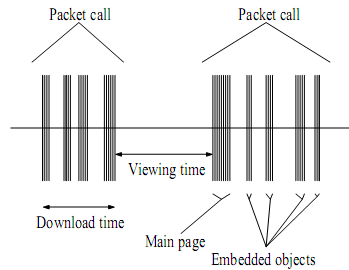
The analysis of the HTTP Model
The analysis of the http model could be performed by determining the nature of the http traffic. The above figure (figure 12) represents the model of http model. A packet call is represented by the download of a web page requested by the end user. It has main page followed by embedded objects. A fresh request of packet data is immediately generated after expiration of the viewing period. The http model is equivalent to an ON/OFF source where the ON state denotes activity of a page request and the OFF state represents a silent period after all objects in that page are retrieved. The download time of a page follows Weibull Distribution where the mean depends on underlying bandwidth of the channel.
There are other parameters that are used to generate http traffic. These are represented by the table below.
Table 3: statistics for the http traffic
(Source: Mainak C., Giridhar, D.M., Sajal, K. D., n.d.p.4)
Table 4: simulation of parameters
(Source: Mainak C., Giridhar, D.M., Sajal, K. D., n.d. p.4)
Analysis of the Fast ARQ
In the fast ARQ scenario, every object for instance the main page or the embedded objects is divided into multiple equal sized RLC data packets. The transmitter transmits one RLC data packet in every 2 ms thus three slots for the PHY layer frame and waits for the ACK. If it happens that the ACK fails to arrive, in the three slot timings, the frame is retransmitted immediately. This is followed by re-initialization of the ACK timer for the packet data.
By looking at the downlink channel, it cannot be said with precision if the ACK or the NACK delivers QoS at the slot boundaries. But the PHY layer boundary is more precise in terms of QoS. This is because when using receivers in the reverse link, the base station is exposed to the challenges of processing delay. This implies the number of retransmission trials is within the ranges of one to three. In such a case, if the packet data is not successfully received or combined at the receiver, even following possible maximum number of retransmission, what follows is that the RLC initializes a retransmission. If it is assumed that the Mac layer has equivalent size as the RLC frame, then the data packet on the ARQ instance is transmitted via an outband signaling which is independent of the throughput.
It is worth to note that the HSDPA MAC header is much less than an octet which increases the minimal overhead. The table below describes the other simulations parameters.
It has been established that QoS support scheduling algorithms in wireline networks don’t rhyme with QoS support scheduling algorithms for a wireless network. This means the support scheduling algorithm for an HSDPA wireline network cannot support scheduling algorithm for HSDPA wireless networks because the HSDPA. Another contributing factor is that in wireless networks, the end-users channel capacities are likely to vary with time or subject to synchronous characteristics. Some researchers have reported that the Earliest Deadline First (EDF) Algorithm that has capabilities for supporting QoS Aware scheduling for the wireline network cannot support optimum QoS in the wireless networks. Past research work on scheduling algorithms have looked into basically two specific areas of interest namely the end-user’s traffic types or traffic based QoS and channel conditions dependent QoS.
Traffic oriented scheduling algorithms are developed to guarantee QoS for the end-users. These scheduling algorithms include Real Time (RT) traffic algorithms, non-Real Time (nRT) traffic algorithms and Best Effort (BE) traffic Algorithm.
Some of the common algorithms for the NRT packet data scheduling include the Maximum Carrier to Interference (Max C/I), Round Robin (RR), Proportionally Fair (PF and the Fast Fair Throughput (FFTH). The PF and its corresponding extensions have potential to provide a recommendable balance between the system throughput and fairness without taking into consideration QoS provision. Al-Manthari et al reported in their studies that the Fair and Effective Channel Dependent (FECD) scheduling algorithm as the best for accounting for QoS while still balancing the system throughput and fairness (Shakkottai and Stoyar, 2001).
Berggren and Jantti proposed Fair Transmission Scheduling algorithm that achieves better performance than the FECD. On the other hand, Jiang, presented a utility based approach for the BE traffic. All in all, the most commonly used algorithm for the HSDPA is the Max-Weight Based algorithm that includes Large Weighted Delay First (LWDF), Modified Largest Weighted Delay First (MLWDF). Research interests have investigated QoS schemes in wired networks for the HSDPA wireless environments with much consideration for the Delay Sensitive Dynamic Fair Queuing (DSDFQ) which is a function of a sorted priority queue mechanism that utilizes virtual finish time in Weighted Fair Queuing Algorithm (WFQA). The WFQA is commonly utilized in wireline networks.
Chaporkar and Sarkar carried out studies on Channel State Aware (CSA) scheduler in the wireless environment. Shakkottai and Stolyar demonstrated related results of Token Based Scheduling Scheme (TBSS) that is commonly adopted for the RT and nRT users. Shakkottai and Stoyler adopted the EXP scheduling for the RT services and reported improved QoS. The basis of EXP scheduling is that in the event the RT end-users are absent, the EXP scheduler allocates leftover capacity to nRT end users through PF mechanism. The only observed shortcoming in the EXP scheduling scheme is that it does not factor for channel efficiency utilization which has an effect of affecting negatively resource allocation.
Recent studies on HSDPA network scheduling have tried to utilize stationery channel modeling which has not achieved much success because it does not factor mobility of the end users. Further research in the same line of utilization of stationery channel modeling have created improved based on Effective Capacity modeling that has capabilities for accounting for efficient bandwidth and QoS provisioning. The main disadvantage that has been observed with this set up is likelihood of failures that arte subject to Dynamic Link Rate (DLR). The Dynamic Link Rate is very pronounced in the HSDPA. Contrary, improvement in this area needs to adopt Stochastic Markov Process that is a function of Finite State Channel (FSC) modeling (Pimentel, Falk and Lisboa, 2004). The FSC has been widely accepted and forms foundation of many fast scheduling algorithms. Some of the models that have utilized this concept include the Gilbert Elliot Channel (GEC), the Finite State Markov Channel (FSMC), the General Hidden Markov Channel (GHMC) and the K-th Order Markov Model (KOMM).
The packet scheduling algorithm will attempt to approximate the effect of combination of the Mac layer and the RLC layers and evaluate if they are able to provide a retransmission that has capability of enhancing the performance of the HSPA system. This will form basis for future studies on slot allocation that have potential to improve QoS of the HSPA system. The algorithm will also evaluate possibilities of the packet data scheduler requirements for queuing analysis that can be performed for the wireless 3.5G networks and assist in providing QoS support for RT traffic, BE traffic and nRT traffic. The simulation model will be build around the link layer channel model that will combine both the Mac and RLC layers of the OSI model.
The Analysis of the Link Layer Channel Model
In terms of HSDPA and HSUPA, there is potential for wireless transport capabilities for a variety of end users and this is exposed to the challenges of changes over a varied time period due to different mobility states of the end user. These can also have a defined characteristic channel fading. At the same time, the wireless transport capabilities for a HSPA system is subject to burstiness. By virtue of having a transport segment per every slot of the OSI model being larger than the packet data magnitude that is observed in wireline networks, there exists possibilities where one data transport segment is able to transport a host of incoming data packets. This is implemented in such a way that all the incoming data packets should be put in a transmission queue awaiting a scheduling mechanism to execute. This implies that a work conserving scheduler is not likely to be optimal. This aspect brings about contrast between a wireless and a wireline system. Under normal conditions, when there are sufficient packet data in the transmission queue to be sent, the channel is assumed to be in the best conditions. A subscriber for the HSPA services is selected and the n the packet data is transported at the best possible rate without consideration for the best channel gain parameter.
Thus, the model adopted in this study is a statistical segment channel where it is assumed that the channel conditions for a variety of users are all linearly independent. This aspect is delivered by dividing the time for every end user I, into intervals defined by a time interval s which shows similarities with the PHY layer channel model.
This means T={[0,Ti], [Ti,2Ti], [2Ti,3Ti],…,[s.Ti ,(s+1)Ti+1]}
In the above mathematical model, the Ti represents the size of one time segment or one scheduling cycle. It is important to note that the Ti of every user is likely to be different and dependent on the user’s PHY channel.
This means every segment s contains time slots Ti. In this case we utilize the mathematical function ri(t) in the model as the magnitude of the data that can be transmitted to the RT user I at time t or possibilities of a feasible data rate at specific time t subject to choosing user i. this gives implication that the mathematical function ri(t) denotes the transport segment size for every slot which in real time is determined by the CQI report (figure 13) of the user I at time t. this is found to be distinct from the PHY layer parameters like the signal to noise ratio. The signal to noise ratio is commonly adopted in channel fading model.
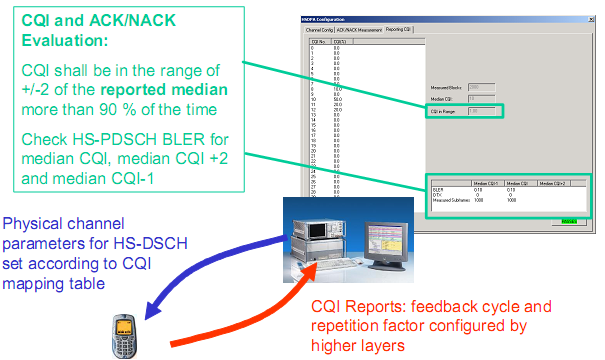
This scenario represents a mathematical mapping that is reported by the CQI values and the feasible rates applicable to the user categories as stated in the 3GPP standards. This implies that for every segment s, there exists a feasible data rate for every user I that varies over time that is represented mathematically by a Ti by 1 vector.
That is termed as ris (t) where T=s, Ti, s.Ti +1, ….., s.Ti Ti-1
Such that ris (t) is found to be the feasible vector for user i for a time segment s. the property of the feasible rate vector is represented by the statistical parameters that are defined by segment mean μis and segment standard deviation σis for a given time segment s such that mis = E[ris (t)]; t Є [s.Ti (s+1).Ti); s ≥ 0
For a statistical segment channel model, the on stationery property of fading channel can be characterized as indicated below within a segment s, instant rate ri(t), (t=s.Tis.Ti+1,…., S.Ti+Ti-1is established to exhibit a fluctuation around a mean μis by a variance defined by (σi2)s. if there is possibility of a mean value represented by μis where (p = 0,1,2,3,…)are assumed to be time variant representing a non stationery channel conditions, then the segment standard deviation σis would represent a short term channel fluctuations and variations of the segment mean μis which would represent a long term spatial non stationery channel fluctuation.
This study assumes a base station has capability to serve N RT users and M nRT users. In general, this would form combination of M by N vector matrix which is a product of M by 1 vector matrix and 1 by N vector matrix.
The base station transmits in slots for a definite period of time. By assuming that the base station transmits to only one user with best channel gain hence a unit vector matrix, for every slot such that there exists a 2 MS in the HSDPA, subject still to possibilities that the base station has capabilities for transmitting to a variety of users at the same time in the HSDPA. The scheme can be extended to multiple users hence providing a scenario of a M by N vector matrix.
Figure 14 represents the proposed structure as a component of a vector matrix. The nRT service is a subset of interactive and background classes. The primary objective is to provide support for QoS to RT end users while at the same time ensuring the NRT end users are provided with BE services.
RT end users in the 3GPP have been categorized into two main classes namely the streaming and the conversational. The QoS support scheduler is a proposed framework that has been implemented in Cyclic APO algorithm. In order to bring about support for QoS for the RT services, the Scheduler should be able to provide a higher priority to N RT traffic. This means the Scheduler should serve RT services first and then any leftover capacity should be allocated to the M nRT users that are utilizing the PF scheduling algorithm. This implies that the 1 by N vector matrix is given priority to the M by 1 vector matrix (Shakkottai and Srikant, 2003).
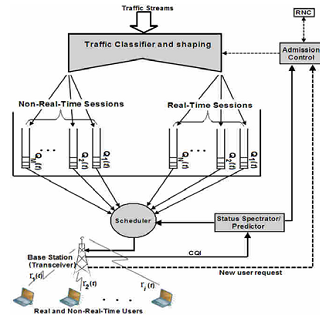
Simulation Results
Introduction
This section reports on the simulation results that were made following use of the simulation model. It analyses the delay characteristics, throughput and RLC recovery results at different values of M that range from M=1 to M=2 although it still projects results that could be observed at M=n as well as misinterpretations that are likely to occur subject to delay, throughput and RLC recovery percentages. These results were produced following comparative studies on channel usage efficiencies of three algorithms namely the OOS, APO and the MLWDF.
This study compares the performance of the Cyclic APO algorithm with MLWDF algorithm that is adopted for the RT scheduling for the EDGE, HSDPA and HDR and PF algorithm that is adopted for the nRT service provision.
A HSDPA base station is made up of 12 attached users, where 6 users have RT while the other 6 users are on nRT. 12 CQI sets are generated simultaneously for all the RT and nRT users and each of the CQI set contains at least 2000 CQI values that represent the variations of the channel conditions.
The non-stationery channel condition for every use ri(t) is simulated by a time varying complex that is a function of Gaussian random variable. The initial mean CQI values μio in time segment 0 is represented by the table below
Table 5: initial mean values of CQI
In order to reduce complexity of the channel estimation function in the simulation, it is important to assume that the mean feasible rate μis of the generated CQI set increases or decreases in a random linear function.
The study mechanism was tailored to achieve its objects by comparing the channel usage efficiencies of the three schemes in sample slot assignment for one hypothetical user i at one scheduling cycle with MLWDF, Optimal Offline Scheduling (OOS) algorithm and the PF.
Mechanism of QoS performance analysis
The QoS performance analysis were further achieved through comparative studies on the APO, PF and WLWDF algorithms by making use of the service curve.
The maximum delay, jitters and buffer size are less than Dmax (t), Jmax(t) and Qmax(t). This means that even if there exists a situation where there occurs prevalence of unsatisfied time segments under overloaded situations, the delay and the buffer sizes still occur in the range of the bounded values.
Based on these results, further studies were carried out to compare efficiencies of the three algorithms subject to delay characteristics, packet throughput and RLC recovery. On the same note, the three algorithms were used to compare efficiencies subject to ACK and NACK and the potential for affecting delay characteristics of packet transmission, throughput packet and RLC recovery.
Figure 15 indicates PF algorithm posts the highest delay that is observed when maximum (M) number of the allowed retransmission at the MAC layer undergoes variations. The results indicate that the delay that arises when PF algorithm is used is extremely high when only the RLC retransmission is investigated. This is based on the value M=0. If there is only one retransmission, where M=1, the observations made demonstrate that there is improvement on the delay. For higher values of M for instance M=2, M=3,….M=n where nth number is infinity, the difference in delay characteristics is not significant on OSS and MLWDF. This is subject to the fact that immediately after the second retransmission, most of the packet data that had been lost is fully recovered which means there is no need for the third retransmission.
The figure 16 represents throughput of the system. In this case, the throughput is measured based on MAC layer and the RLC layer in all the three algorithms. From the results, it is apparent that the throughput decreases as the FER increases indicating an inverse proportionality. OOS and APO algorithms appeared the best algorithms to adopt based on the throughput of the systems. PF algorithm posted the least throughput for RT but the best for the nRT users. This provided a scenario on inverse proportionality based on throughput of the system. Existence of this phenomenon is realistic since large values of FER results into damage of more packet data during transmission and this brings about an effect such that the number of the retransmitted data increases. OOS was found to be the best algorithm for the RT users but posted an equivalent characteristic throughput with MLWDF.
Figure 17 provides analysis of efficiency of RLC being able to recover the missing data packets following retransmission. OOS algorithm appeared the best for recovering lost packets data while PF algorithm appeared the least. This correlated with the RT throughput for the systems. The x-axis provides a scenario that is characteristic of the packets data that are recovered by the RLC. What happens is that the fast ARQ mechanism is turned off which implies that at M=0, all the missing data packets are recovered by the RLC. If a point M=1 is considered, then the results indicate that there occurs a decrease in the RLC recovery. This happens because the MAC layer has potential for recovering lost data packets in one retransmission. Considering points M=2, and M=3 …. M=n, the recovery of the RLC is found to be zero. This is because at M=1, all lost data packets had been recovered and therefore M=2, or M=3 results into non-significant delay. This scenario was the opposite for the nRT users where PF algorithm still appeared the best algorithm.
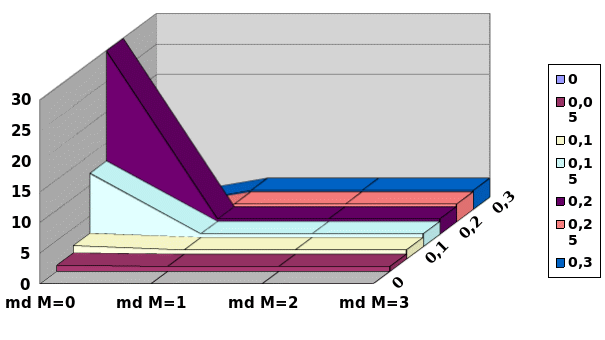
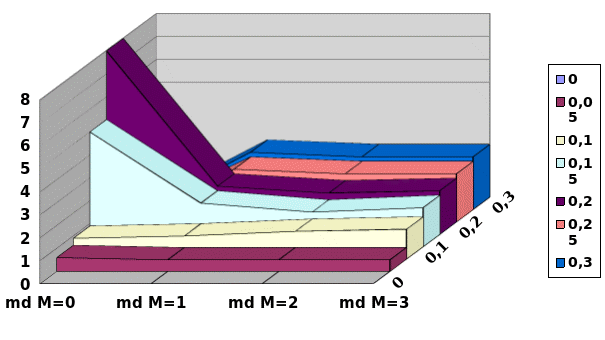

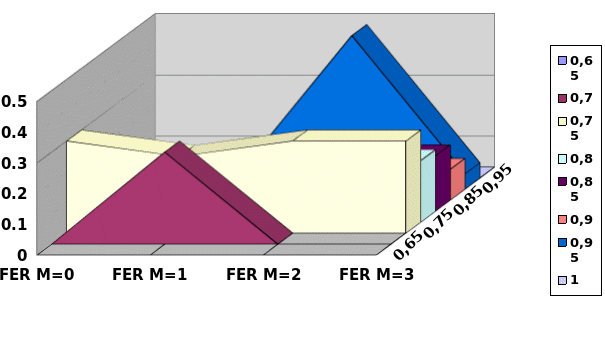

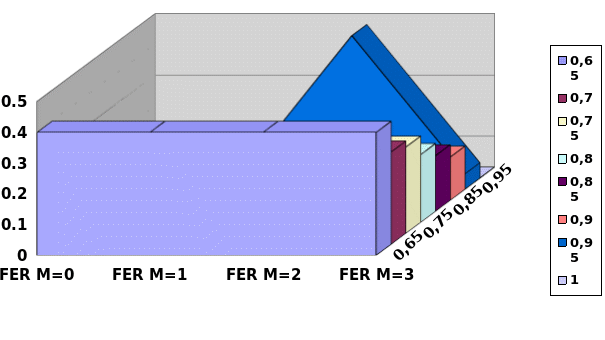
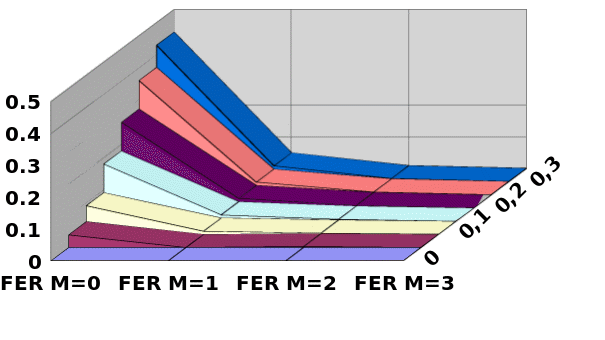
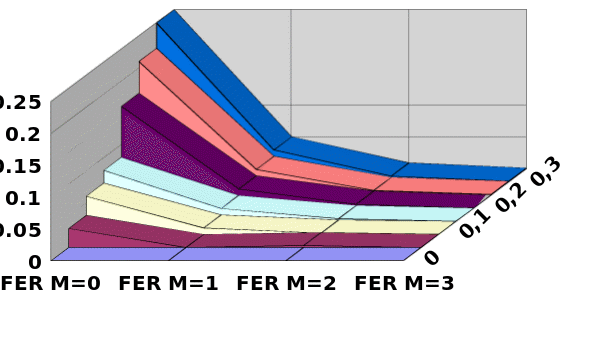
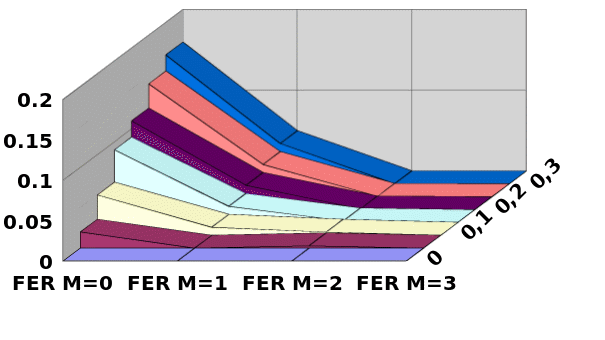
Misinterpretation of Ack or Nack
This section reports on comparison possibilities that may arise following misinterpretation of ACK or NACK when using three algorithms namely the APO, OOS and the MLWDF.
It is observed that there is minute or negligible probability that elements of ACK or the NACK are likely to be misinterpreted in the three algorithms. This confusion occurs when the decoder at the transmitter interprets ACK as NACK or NACK as ACK. What happens is failure of transmission of the data packet if it is ideally assumed for correct reception. The three algorithms were all affected by equivalent degree of false ACK.
The RLC at the receiver executes the process by detecting the missing data packets and immediately initiating a retransmission mechanism that is geared towards recovering the missing data packets. OOS algorithm and APO appeared the best respectively while PF provided the least channel usage efficacies. If a scenario exists such that the ACK is decoded as the NACK, the retransmission mechanisms is stimulated by the MAC layer if there exists a situation where the maximum number of retransmission has not been attained.
In the event the maximum number of the retransmission at the MAC layer is exhausted, what happens is that the RLC will recover the missing packets. It does not however depend on the layer that finally executes the recovery mechanisms because in either way, the end result is a duplicate retransmission of a previously received packet data. This was found to be similar for all the three algorithms with OOS tending to exhibit superiority over MLWDF and PF algorithms respectively.
It can be noted that any form of wrong interpretation at the Mac layer is only detected by the RLC layer. This means that reliability aspect of the RLC layer should be strongly emphasized. The reason behind the failure to ignore RLC layer functional properties with respect to reliability is because the real benefits of the RLC layer are a function of reliability. OOS algorithm was the best and PF the least. This aspect is of paramount importance due to the fact that the percentage of the Error Recovery rate by the RLC layer is dependent on the percentage of the misinterpretations which denotes a direct proportionality. This parameter is termed as a ‘false ACK’ and was more prevalent with the PF algorithm as opposed to the OOS.
Observed results with false ACK
The investigation for the determination of the false ACK results was carried by adopting simulations that were a function of a specified percentage of misinterpretations of the ACKs by using three algorithms namely PF, OOS and the MLWDF. The ranges for the observed misinterpretations lied within a percentage range of f=1% to f=5% for all three algorithms.



The figure 18 on delay illustrates a situation where the observed mean delay was at M=2.

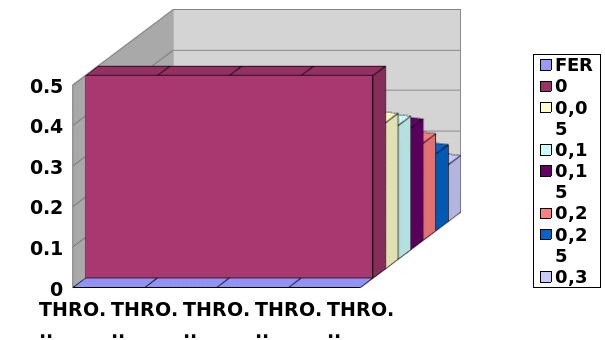

Figure 19 on throughput illustrates a degradation in the systems performance in terms of throughput at M=2. It was found that the percentage of the RLC recovery for M=2 is represented by figure 16 on RLC Recovery and the OOS algorithm appeared the best in channel usage efficiency.

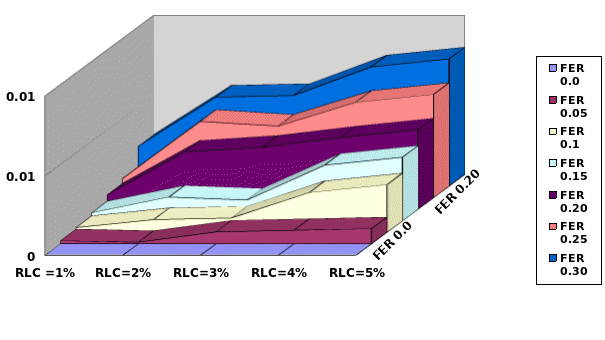

The observed percentage of RLC recovery for M=2 is represented by figure 20 above. With M=1, the RLC exhibits potential to recover more data packets that it is observed at M=2. This is observed for the OOS algorithm as opposed to PF system scheme. This observation is realized because when two retransmissions occurs at MAC layer, it results into recovery of data packets that were damaged or lost. OOS algorithm scores the best followed by MLWDF and PF algorithms. The role of RLC is therefore to recover data packets that were misinterpreted. In some instances, though, it is observed that the RLC recovery is greater than the FER values. This study however did not concern itself with a greater than a 30% FER because at high FER, higher error rates will result as well as possibilities of serious consequences while maintaining the link.
Conclusion
This section reports on the conclusions that were made and any policy framework that was derived from the study. The section also provides knowledge that the study has added into the literature on HSPA as a function of HSDPA and HSUPA through the comparative studies of the five algorithms namely APO, OOS, PF and MLWDF, and WLWDF. This section concludes with a recommendation for future studies on HSPA and proposes directions that future studies should take in order to lead into improvement of QoS and QoE from the utilization of the HSPA.
The Quality of packet scheduling is an important aspect that affects operations of HSDPA directly. This is because the HSDPA controls distribution of scarce radio resources among mobile UEs. This comparative study of algorithms channel usage efficiencies established that the primary idea behind cyclic APO was that APO prefers users who have the least probability of getting an optimal channel state as a future slot that the current slot. Through adoption of APO, the UEs would be able to utilize cyclic APO in order to maximize channel capacity with QoS support. The experimental results have shown that using APO algorithm achieves a sustainable channel efficiency for all scenarios as functions of RT and nRT users as opposed to the OOS and MLWDF algorithms that achieve best channel usage efficiencies for only one parameter.
Conclusion
In this study, it has been demonstrated that the combination of the RLC and MAC layers retransmission have capability of improving the performance of the 3.5G wireless network as well as enhancing the QoS of the 3G wireless networks subject to application of OOS and APO algorithms for the RT users. The study has demonstrated that the MAC sub layer of the OSI model has capability of instantaneously recovering damaged packet data before the RLC layer takes over when the maximum possible Mac layer retransmissions are attained.
The study has illustrated that owing to soft data packet combination, the effective FER that is experienced by the data packets that are undergoing retransmissions either at Mac layer or RLC layer, is decreased for every retransmission for the PF algorithm as opposed to the OOS and APO algorithms. By using simulation results, it has been demonstrated that fast retransmission mechanism that occurs at the Mac layer has capability for improving the system performance. From the simulation results, it was established that a lot of improvement in the number of retransmission at the Mac layer should be improved from the observed M=2 by using the APO or the OOS algorithm or developing an algorithm that integrates both features of OOS and APO algorithms. The simulation results helped to determine that the recovery carried out by RLC layer is important if the FER is high as well as where there exists a threat of possible ACK misinterpretation that is very pronounced in the Mac layer.
The study realized its objectives by determining that delay characteristics, data packet throughput and RLC recovery for values ranging from M=1 to M=2 and projecting results for the values of M>2. The study also realized the misinterpretations that have potential to interfere with delay, throughput and RLC recovery at different values of maximum number of retransmissions (M). The study established that improvement of delay occur at M=1 while at higher values of M, for instance M=2, 0r M>2, the QoS subject to delay was not significant because after the second retransmission, at M=2, all data packets that had been lost are fully recovered. This means any additional retransmission is not necessary.
The study established that the throughput decreases as the value of FER increases. It was established that at high values of FER, there was increased damage or loss of packet data. It was found that at M=0, it was possible for all lost data packets to be recovered by using RLC layer.
The study found out that false ACK is likely to result which leads into delay characteristics at M=0 to M=2 where all exhibit equivalent delay characteristics, throughout and RLC recovery rates. This aspect holds true for all FER is greater than 30%.
The study adds knowledge to the literature of HSPA by reporting that the RLC receiver has capabilities of detecting any missing packet data and immediately initiating a retransmission of the missing packet data when APO algorithm or OOS algorithm was applied. The study reports that RLC layer is used for recovering data that Mac layer has failed to recover and this results when the MAC layer retransmission attains maximum possible number of transmissions. The study reports that the Mac layer is only capable of recovering data on its first retransmission under support of an algorithm that supports channel usage efficiencies. The study reports that elements of ACK or NACK are exposed to threat of being misinterpreted subject to the decoder at the transmitter interpreting ACK as NACK and vice versa. This misinterpretation was found to have capabilities of leading into failure of retransmission of the packet data.
The study also established that in terms of assigning serving slots for packet transmission, OOS algorithm was the best followed closely by the APO algorithm.
The study reports that if the ACK was decoded as the NACK, then the retransmission was executed by the MAC layer else the retransmission was carried out by the RLC layer subject to application of APO algorithm or the OOS. This gives implication that whenever the maximum number M of Mac layer transmission are attained, it is the role of the RLC to carry out retransmission which occurs at M=2 under the support of OOS or APO algorithms. This result was illustrated best by using the APO algorithm and OOS algorithm respectively but was very diminished under the PF algorithm.
In conclusion, it becomes critical to note that as the demand for the RT wireless data communication increases, there is need for more efficient fast protocols that ought to be designed to meet the demand requirements and improve on QoS and QoE. HSDPA is a major component for a WCDMA system with potential to allow data bit rates of up to 10 Mbits/s. it is important to recover lost or damaged data packets in order to improve QoS of the end users that requires retransmission at lower layers excluding the TCP layer of the OSI model.
Policy framework of the study
The study highlights that RLC frame and the MAC sublayer facilitate performance of the HSPA system as a function of HSDPA when supported by a good performance algorithm that is able to maintain sustainable channel usage efficiencies. The fast transmission of packet data at the Mac sublayer recovers most of the data subject to maximum allowed retransmission else the RLC frame takes over the process of transmission. The study notes that soft packet combination and effective FER that is experienced by the packet data when undergoing retransmission is lowered in every successive retransmission and this was demonstrated by the OOS and APO algorithm and was highest in the PF algorithm. The recovery of the packet data by the RLC frame continues if the FER is high and when the ACKs are misinterpreted at the MAC sublayer
Future research work
Future research work should be based on investigating the simulation models that can determine delay characteristics and throughput of the data packet in a HSPA system as a function of the HSUPA. There should studies to investigate misinterpretations that may lead into delay characteristics and data packet throughput in a HSPA as a function of HSUPA. Future studies should address time segmentation based algorithm that implements a non conserving scheduling scheme with an algorithm like the OOS and APO.
List of references
3GPP.TR 25.848V4.0.0, 2001, Physical Layer Aspects of UTRA High Speed Downlink Packet Access.
3GPP.TR 25.950 V4.0.0, 2001, UTRA High SpeedDownlink Packet Access, 6.1.0.
Al-Manthari, B., Nasser, N. and Hassanein, H. 2006, Fair Channel Quality Based Scheduling Scheme for HSDPA System, Proceedings of the IEEE International Conference on Computer systems and applications: IEEE Computer Society Washington, DC, USA.
Ameigeiras, P., 2003, Packet Scheduling and Quality of Service in HSDPA, Ph. D. Thesis, University of Aalborg (Denmark).
Andrews, M., Kumaran, K. Ramanan, K., et al., 2004, SCHEDULING IN A QUEUING SYSTEM WITH ASYNCHRONOUSLY VARYING SERVICE RATES, Probability in the Engi-neering and Informational Sciences, vol. 18, no.02, pp. 191-217.
Arauz, J., Krishnamurthy, P. and Labrador, M. A. 2004 Discrete Rayleigh fading channel modeling, Wireless Communications and Mobile Computing, vol. 4, no.4, pp. 413-425.
Bakre, A. and Badrinath, B.R. 1995, “I-TCP: Indirect TCP for Mobile Hosts”, In Proc. 15th Internationals Conference on Distributed Computing Systems, pp. 136-143.
Bao, G. 1996 “Performance evaluation of TCP/RLC protocol stack over CDMA wireless links”, ACM Wireless Networks Journal, Vol. 2, pp. 229-237.
Bauch, G. and Franz, V. 1998 “A comparison of soft-in/soft-out algorithms for “turbo-detection”,” in Proc. of Int. Conf. on Telecommunications (ICT),Porto Carras, Greece, pp. 259–262.
Baumgartner, T. 2003, Smart Antenna Strategies for the UMTS FDD Downlink. PhD thesis, TU Wien.
Berggren, F. and Jantti, R., 2004, Asymptotically fair transmission scheduling over fading channels, Wireless Communications, IEEE Transactions on, vol. 3, no.1, pp. 326-336.
Caceres, R. and Iftode, L. 1995 “Improving the Performance of Reliable Transport Protocols in Mobile Computing Environments”, IEEE Journal on Selected Areas in Communications, 1995, Vol. 13, pp. 850-857.
Cessner, C. 2005 High Speed Downlink Packet Access (HSDPA): Test and Measurement Requirements, Rohde & Schwarz: 1MA82_0e.
Chang, K. and Han. Y., 2002, QoS-based adaptive scheduling for a mixed service in HDR system, Personal, Indoor and Mobile Radio Communications 2002, The 13th IEEE International Symposium 2002.
Chaporkar, P. and Sarkar, S. 2002, Providing stochastic delay guarantees through channel characteristics based resource reservation in wireless network, Proceedings of the 5th ACM International Workshop on Mobile Multimedia WoWMoM, Atlanta: ACM Press New York, NY, USA.
Chockalingam, A. and Bao, G. 1999, “Performance of TCP/RLC protocol stack on correlated fading DSCDMA wireless links”, IEEE Transactions on Vehicular Technology, Volume 49, Issue 1, pp. 28-33.
Choi, H.K. and Limb, J.O. 1999, “A Behavioral Model of Web Traffic”, International Conference of Network Protocols (ICNP) pp. 327-334.
Comer, D.E. 1991 Internetworking with TCP/IP, Vol. 1, Prentice-Hall.
ETSI, 1998, Selection procedures for the choice of radio transmission technologies of the UMTS, TechnicalReport TR 101 112, 3GPP.
Forkel, I. and Klenner, H., 2004 “High speed downlink packet access (HSDPA) – A means of increasing downlink capacity in WCDMA cellular networks?” in Proc. of the 5th European Wireless Conference 2004, Barcelona, Spain.
Freudenthaler, K., Kaltenberger, F., Paul, S. et al 2005 , “Cancellation of interference from synchronization and pilot channels on high speed downlink shared channel in UMTS,” in Proc. of the 11th European Wireless Conference 2005, Nicosia, Cyprus, 2005, pp. 498–503.
Geirhofer, S., Mehlf¨ uhrer, C., and Rupp, M. 2005 “Design and real-time measurement of hsdpa equalizers,” in Proc. of the 6th International Workshop on Signal Processing Advances for Wireless Communications (SPAWC), New York City, USA.
Harteneck, M., Boloorian, M., Georgoulis, S., et al., 2004 “Practical aspects of an HSDPA 14 Mbps terminal,” in Proc. of the 48th Annual Meeting of the International Society for the System Sciences (ASILO-MAR), Pacific Grove, USA, pp. 799–803.
Jiang, Z., Ge, Y. and Li, Y. 2005, Max-utility wireless resource management for best-effort traffic, Wireless Communications, IEEE Transactions on, vol. 4, no.1, pp. 100-111.
Kaltenberger, F. Freudenthaler, K. Paul, S. et al, 2005 “Throughput enhancement by cancellation of synchronization and pilot channel for UMTS high speed downlink packet access,” in Proc. of the 6th International Workshop on Signal Processing Advances for Wireless Communications (SPAWC), New York City, USA.
Kolding, T.E., Pedersen, K.I., Wigard, J., et al, 2003, High Speed Downlink Packet Access: WCDMA Evolution, In IEEE Vehicular Technology Society News IEEE.
Mailaender, L., 2001, “Low-complexity implementation of CDMA downlink equalization,” in Proc. Second International Conf. on 3G Mobile Communication Technologies, no. 477, pp. 396–400.
Members of 3GPP, 2003 “Technical specification group radio access network; spreading and modulation (FDD) (3GPP TS 25.213 version 6.0.0).
Members of 3GPP, 2004 “Technical specification group radio access network.
Members of 3GPP, 2004b, “Technical specification group radio access network; UE radio access capabilities definition (3GPP TS 25.306 version 6.3.0).
Multi-plexing and channel coding (FDD) 3GPP TS 25.212 version.
Mohammadreza, H.N., Zuriati, A.Z., Nur, I. U. et al 2009, Efficient scheduling algorithm for QoS support in high speed downlink packet access networks, World academy of science, engineering and technology, Vol. 50.
Pimentel, C., Falk, T. H. and L. Lisboa, 2004 Finite-state Markov modeling of correlated Rician-fading channels, Vehicular Technology, IEEE Transactions on, vol. 53, no.5, pp.1491-1501.
Schniter, P. and Margetts, A. R.,2002 “Adaptive Chip-Rate Equalization of Downlink Multirate Wideband CDMA,” in Proc. 36th Asilomar Conf. on Signals, Systems and Computers, vol. 2, pp. 1228–1232.
Shakkottai, S. and R. Srikant, 2003, Scheduling Real-Time Traffic With Deadlines over a Wireless Channel, Wireless Networks, vol. 8, no.1, pp. 13-26,
Shakkottai, S. and Stolyar, A. 2001, Scheduling algorithms for a mixture of real-time and non-real-time data in HDR, Proceedings of 17th International Teletraffic Congress (ITC-17).
Shao, H. R., Shen, C. Zhang, J, et al , 2003.Dynamic resource control for high-speed downlink packet access wireless channels, Proceeding of 23rd International Conference on Distributed Computing Systems Workshop, pp. 838-843.
Turin, W. and R. Van Nobelen, 1998, Hidden Markov modeling of flat fading channels, Selected Areas in Communications, IEEE Journal on, vol. 16, no.9, pp.1809-1817
Valenti, M. and Sun, J. 2001, “The UMTS turbo code and an efficient decoder implementation suitable for software-defined radios,” International Journal of Wireless Information Networks, vol. 8, no. 4.
Wu, D. and R. Negi, 2003, Effective capacity: a wireless link model for support of quality of service, Wireless Communications, IEEE Transactions on, vol. 2, no.4, pp. 630-643.
Bibliography
Andrews, M., Kumaran, K. Ramanan, K. Stolyar, A. Vijayakumar, R. and Whiting, P. , 2004, SCHEDULING IN A QUEUING SYSTEM WITH ASYN-CHRONOUSLY VARYING SERVICE RATES, Probability in the Engineering and Informational Sciences, vol. 18, no.02, pp. 191-217.
Booz, A and Hamilton, UMTS Forum, 2006. Thriving in harmony –Frequency harmonization: the better choice for Europe.
Dahlman, E. et al., 2006, Vehicular Technology Conference, 2006. VTC 2006. IEEE 63rd. The 3G Long Term Evolution –Radio Interface Concepts and Performance Evaluation, IEEE VTC2006.
Dogandzic, A. and Jin, J., 2005, Estimating statistical properties of MIMO fading channels, Signal Processing, IEEE Transactions on vol. 53, no.8 Part 2, pp. 3065-3080.
Global Mobile Suppliers Association (GSA). Web.
Hiltunen, K., Lundevall, M. Magnusson, S. Res E., Olme A.B. and Jorvas, F., 2004,Performance of link admission control in a WCDMA system with HS-DSCH and mixed services, 15th IEEE International Symposium on Personal, Indoor and Mobile Radio Communications, PIMRC2004.
IEEE-SA. 2006. IEEE 802.16e-2005 Air Interface for Fixed and Mobile Broadband Wireless Access Systems: Part 16: Air Interface for Fixed and Mobile Broadband Wireless Access Systems. Web.
IEEE-SA. 2004. IEEE 802.16-2004 Air Interface for Fixed Broadband Wireless Access Systems. Part 3: Radio Conformance Tests (RCT) for 10-66 GHz WirelessMAN-SC™ Air Interface. Web.
Kaaranen, H., Ahtiainen, A., Laitinen, L., Naghian, S.K. and Niemi, V., 1999, “UMTS Networks: Architecture, Mobility and Services”, Wiley & Sons Publishing, 2001.
Marzetta, T. L., 1995, EM algorithm for estimating the parameters of a multi variatecomplex Rician density for polarimetric SAR, in Acoustics Speech, and Signal Processing , ICASSP-95, vol. 5, pp. 3651-3654.
Nokia. 2005, White Paper: Nokia HSDPA Solution. Web.
Parkvall, S., Dahlman, E., Frenger, P., Beming, P. and Persson, M., 2001, “The evolution of WCDMA: Towards Higher Speed Downlink Packet Data Access “, in Proceeding of IEEE Vehicular Technology Conference (VTC).
Rysavy, P., 3G Americas. 2006. Mobile Broadband: EDGE, HSPA and LTE. Web.
Souissi, S. and Wicker, S.B., 1995, “A Diversity Combining DS/CDMA System with Convolutional Encoding and Viterbi Decoding”, IEEE Transactions on Vehicular Technology, Vol. 44, No. 2, pp. 304-312.
Stevens, W.R., 1994, “TCP/IP Illustrated”, Addison Wesley, TIA/EIA/IS-707-A.2, “Data Service Options for Spread Spectrum Systems: Radio Link Protocol”. Web.
List of appendix
Appendix A: High Speed Packet Access (HSPA)
HSPA is abbreviation for High Speed Packet Access. HSPA technology is part of the 3G network family. HSPA is mainly used in the mobile technology for accessing the internet. It is the one of the latest technology that is available today. There are two types of HSPA for uploading and downloading the data namely the HSDPA and HSUPA. The HSDPA is abbreviation for High Speed Downlink Packet Access and HSUPA is abbreviation for High Speed Uplink Packet Access. The characteristic properties of HSDPA include ability to receive data packets easily from the internet, ability to support large file downloads, ability to support email attachments, PowerPoint and different video and audio formats.
HSDPA supports data downloads rates of up to 14.4Mb/sec. The major advantage of this is even a small video clip can be downloaded very fast. HSUPA is use for high speed uplink packet access. The purpose of this is to allow user to upload ant data file format including videos from the UEs.
Appendix B: Universal Mobile Telecommunication Systems (UMTS)
UMTS is abbreviation for Universal Mobile Telecommunication System which is 3G mobile system. The main advantage of UMTS is that it supports majority of the operators and manufactures. UMTS creates friendly access to the mobile features for the user. The architecture of the UMTS consists of Core Network, UMTS terrestrial Radio Access Network (UTRAN) and user equipment. The main function is to provide facilities for the traffic. The facilities can be switching, routing and transit in the traffic. (Overview of the universal mobile telecommunication system 2002)
Appendix C: Voice Telephony and Multimedia Application
The voice telephony is the single integrated infrastructure which is able to administer and distribute to the supported signal like audio signal, data signal, voice signal and video signal. In the recent days, the users of internet have increased and mobile internet dominates the information world. Due to increasing number of internet customers, the need for the users to have support for broad band data transmission has also increased especially increased demand for mobile web based application or multimedia application. This requires support from HSPA as a subset of HSDPA and HSUPA which supports text, audio and video, graphics, text and video.
The term text application media includes text message and text e-mail. This category of data is entirely different from other three, as it is very commonly used for the storing the data bases. The term audio application refer two different types of sounds namely speech or voice. It is the normal human speech that is having the frequency range of below 4 kHz. The main application which used the voice multimedia mode is the telephony related applications. The traditional modes of application are voice mail, audio teleconferencing and telemarketing. In this voice telephony, the music applications and downloading music are also included.
Appendix D: adaptive modulation and coding
The adaptive modulation and coding achieves compensation of varying downlink radio conditions on the HS-PDSCH via fast power control that occurs at a fixed data rate. The data rate adjustments are dependent on measured channel quality in every subframe. It has been observed that the data rate adjustment is attained by puncturing and repetition that is also termed as rate matching process of the rate equivalent to 1/3 of the turbo coded data stream and implemented by selecting either QPSK modulation or 16 QAM.
Appendix E: the description of a simulator of HSDPA
The simulator for a HSDPA link level baseband is implemented in NS-2. The simulator consists of a Node B transmit edge the downlink channel model, the HSDPA receiver and three ringbuffers. The appendix B1 illustrates the description of a HSDPA
Appendix E1: description of a HSDPA simulator

In the HSDPA simulator, every sub-frame of the HSDPA generates the HS-PDSCHs for every selected scheduled users, the SCH, the primary common control channel (P-CCPCH) and the Primary –CPICH. The power that is allocated to the active interfering channels is reassigned to the orthogonal Channel Noise Simulator (OCNS) transmission. The HS-SCCHs are normally signaled error free to the receiver.
The data streams for the HS-PDSCHs are generated randomly. The packet size is defined by the signaled CQI and the UE capability class. The information bits for every user are encoded based on Cyclic Redundancy Check (CRC) attachments, channel coding or turbo coding and HARQ functionality and interleaving.
Every other channel with exception of the SCH is modulated and spread by orthogonal Walsh Hadamard sequences and scrambled by cell specific Gold sequence. The channels are then weighted and added to a single chip stream defined by si. The weighting factors are determined from relative power ratios of the channels to the total transmit power spectral density defined by Ec/Ior. In order to achieve a total transmit power spectral density of Ior = 1 (0dB) while the other channels are generated by the OCNS and are added to the chip stream. The channels have a fixed spreading factor that is equal to 128and are used to simulate the users or control signals on the other orthogonal channels of a downlink.
Appendix F: the chip rate LMMSE equalization
The chip rate equalization is formulated based on criteria of minimizing the cost function and is represented by
![]()
Where f that represents the equalization coefficients si-r is a delayed version of the transmitted chip stream and ri is a column vector of the last Lf received sample
Where f is mathematically represented by
![]()
Where

The value of H arises from the convolution with the channel impulse response denoted by h[i], where I represents identity matrix and er is a unit vector with one at the r-th position. This has been determined to correspond to the delay induced by filters and the channel. The matrix H is calculated from channel estimation which in turn is determined through symbol level least squares estimator.
The LMMSE equalizer is used to correct for any distortion that is brought about by the channel and restores othorgonality. But this occurs at the expense of making the receiver more complex such that the Lf by Lf matrix inverse has to be determined.
Appendix G: demodulation and decoding
LMMSE Equalization of the UE descrambles, dispreads and demodulates its assigned HS-PDSCH channels using the channelization sequences and modulation indices signaled in the HS-SCCH. Then the demodulator returns log-likelihood ratios (LLRs) of the bits. The mathematical representation of the LLR bipolar bit b is defined by
![]()
Where p (.) represents probability and ln (.) represents the natural logarithm.
Appendix D1: HSDPA receiver with LMMSE equalizer and IR buffer
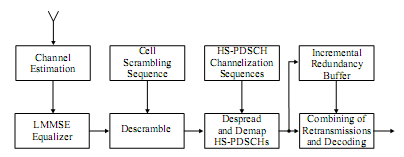
The LLR values are then sent through the inverse rate matching block which sets punctured bits to zero and combines repeated bits that were previously stored in the IR buffer. The result is then stored again in the IR buffer and sent to the turbo decoder. The turbo decoder uses a max-log MAP algorithm that has 8 iteration.
Appendix H: interview outcomes
- Nokia’s view:
“3G HSPA is what’s on the market today (implying Mobile Wimax is NOT really on the market). Nokia is licensing its 3G-HSPA-modem technology as widely as possible within the industry.” (Weissberger, 2009)
AT and T CEO Randall Stephenson
“HSPA and LTE will be the preferred building blocks in many operators’ mobile broadband strategies.” (Virgin mobile USA: still room in the youth market 2007). He added “these technologies will play a key role in the mobile broadband and will need to meet the customer by providing high speed broadband facility in the mobile.
- Robert Jansen, Ericsson:
“Advanced MIMO technology offers the speed or capability of providing the speed more than 140Mbps. He added that by 2011, HSPA would be leading the mobile broadband in the market.
- Michael O’Hara, CMO of the GSMA:
He said, “That the convergence of mobility and broadband is accelerating as technologies like HSPA and LTE provide dramatically enhanced network performance to support mobile broadband.” (Ayvazian & Mitchell 2009). He added that HSPA networks are now doing the operation in more than 118 countries and very soon it will cover other countries also. Because it is offering such a user-friendly technology and will be the king in the mobile internet, it is sure that it will change the people’s life style – personal or official.
- Telstra CEO Sol Trujillo:
He told that his company is focusing to deliver HSPA technology very soon to enhance the features in the mobile broadband. First it will deliver the business customer needs.
- Mr Chan Kin Hung, StarHub, Singapore:
He said that with HSPA technology they can provide best ever mobile broadband in the island. With the help of this technology they are able to provide “true mobility and unparalleled performance to customers in Internet access on the go.” (Starhub launches HSPA+ 2009).He also added that now people can experience best ever speed in the mobile internet with high pace and improved feature. It enables better communication and other facilities for the customer to meet heir needs.
- Mr Chan Kin Hung, Huawei Technologies Co., Ltd.
He said that to fulfill the needs of the customer in the access of mobile internet, the company has to opt for the latest technologies such as HSPA. It has the capability to provide high-speed upload and downlink the packets in the network.
- Peter Erskine, CEO of European mobile operator O2
With the introduction of HSPA, it promises high-speed data in the network. He added that “HSDPA capability was built into the network to provide improved performance over today’s 3G networks.” (Channing 2006). He also said that in future this HSPA will rule the mobile broadband and this will go on attract the users with its high speed and its performance.
- CEO Mobitel, Surein J. Amerasekere
He mentioned that main difference between the HSPA and other technologies is HSPA technology allows the user to upload and download their files faster than 2G or 3G platforms.
- Julien Grivolas, Ovum analyst
“HSDPA will allow mobile operators to offer much faster connection speeds than standard 3G.” (Meyer 2006).
The main advantage of using the HSPA is HSPA can use the spectrum, which has been used for Universal Mobile Telecommunications System (UMTS). So it has been a big advantage for the operators who are opting out for HSPA. They just need only small software upgrade. The HSPA has become very popular because of its fast development.